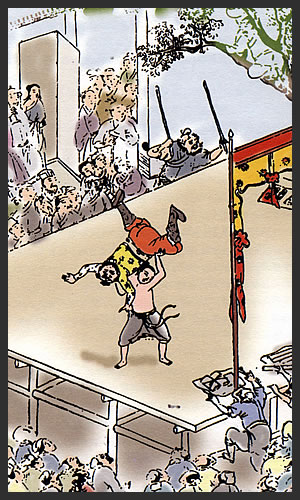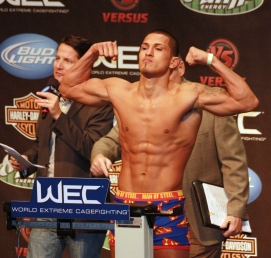|
Cartwheel Kick
''Aú batido'' (cartwheel kick) is a traditional capoeira cartwheel kick, known under various names in breakdancing, MMA and other disciplines. The cartwheel kick originated as a combat kick, but has become very popular as an acrobatic decoration (''floreio''). This is likely the most photographed capoeira move. Like many other core techniques of capoeira, ''aú batido'' originates from engolo. Names The Buntu name for this technique in engolo is ''okusana omaulo-ese'' (cartwheel or handstand kick down). In capoeira, this kick has many names, including ''aú batido'' (cartwheel kick), ''aú quebrado'' (broken cartwheel), ''aú malandro'', ''beija flor'' (hummingbird), ''bico de papagaio'' (parrot's beak) or ''aú Amazonas''. In breakdancing, a showcase version of the cartwheel kick is known as the L-kick. History Engolo, an Angolan martial art considered as ancestor art of capoeira, using multiple cartwheel kicks, including ''aú batido'', as part of its offensive r ... [...More Info...] [...Related Items...] OR: [Wikipedia] [Google] [Baidu] |
Kick
A kick is a physical strike using the leg, in unison usually with an area of the knee or lower using the foot, heel, tibia (shin), ball of the foot, blade of the foot, toes or knee (the latter is also known as a knee strike). This type of attack is used frequently by hooved animals as well as humans in the context of stand-up fighting. Kicks play a significant role in many forms of martial arts, such as capoeira, kalaripayattu, karate, kickboxing, kung fu, wing chun, MMA, Muay Thai, pankration, pradal serey, savate, sikaran, silat, taekwondo, vovinam, and Yaw-Yan. Kicks are a universal act of aggression among humans. Kicking is also prominent from its use in many sports, especially those called football. The best known of these sports is association football, also known as soccer. History The English verb to kick appears in the late 14th century, meaning "to strike out with the foot", possibly as a loan from the Old Norse "kikna", meaning "bend backwards, sink ... [...More Info...] [...Related Items...] OR: [Wikipedia] [Google] [Baidu] |
Mixed Martial Arts
Mixed martial arts (MMA) is a full-contact fighting combat sport, sport based on strike (attack), striking and grappling; incorporating techniques from various combat sports from around the world. In the early 20th century, various inter-stylistic contests took place throughout Japan and the countries of East Asia. At the same time, in Brazil there was a phenomenon called vale tudo, which became known for unrestricted fights between various styles such as judo, Brazilian jiu-jitsu, catch wrestling, luta livre, Muay Thai and capoeira. An early high-profile mixed bout was Masahiko Kimura vs. Hélio Gracie, Kimura vs Gracie in 1951. In mid-20th century Hong Kong, rooftop street fighting contests between different martial arts styles gave rise to Bruce Lee's hybrid martial arts style Jeet Kune Do. Another precursor to modern MMA was the 1976 Muhammad Ali vs. Antonio Inoki, Ali vs. Inoki exhibition bout, fought between boxer Muhammad Ali and wrestler Antonio Inoki in Japan, where ... [...More Info...] [...Related Items...] OR: [Wikipedia] [Google] [Baidu] |
Kicks
A kick is a physical strike using the leg, in unison usually with an area of the knee or lower using the foot, heel, tibia (shin), ball of the foot, blade of the foot, toes or knee (the latter is also known as a knee strike). This type of attack is used frequently by hooved animals as well as humans in the context of stand-up fighting. Kicks play a significant role in many forms of martial arts, such as capoeira, kalaripayattu, karate, kickboxing, kung fu, wing chun, MMA, Muay Thai, pankration, pradal serey, savate, sikaran, silat, taekwondo, vovinam, and Yaw-Yan. Kicks are a universal act of aggression among humans. Kicking is also prominent from its use in many sports, especially those called football. The best known of these sports is association football, also known as soccer. History The English verb to kick appears in the late 14th century, meaning "to strike out with the foot", possibly as a loan from the Old Norse "kikna", meaning "bend backwards, sink at the kn ... [...More Info...] [...Related Items...] OR: [Wikipedia] [Google] [Baidu] |
Breakdance Moves
Breakdancing or breaking, also called b-boying (when performed by men) or b-girling (women), is a style of street dance originated by African Americans and Puerto Ricans in The Bronx borough of New York City. Breakdancing consists mainly of four kinds of movement—toprock, footwork, power moves, and freezes—and is typically set to songs containing drum breaks, especially in funk, soul, and hip-hop. Its modern dance elements originated among the poor youth of New York during the early 1980s. It is tied to the birth of hip-hop, whose DJs developed rhythmic break for dancers. The dance form has expanded globally, with an array of organizations and independent competitions supporting its growth. Breaking became an Olympic sport at the 2024 Summer Olympics in Paris, as per a December 7, 2020 decision by the International Olympic Committee, after a proposal by the World DanceSport Federation. Terminology The term derives from the dancers who saved their best moves for the in ... [...More Info...] [...Related Items...] OR: [Wikipedia] [Google] [Baidu] |
Capoeira Techniques
Capoeira () is an Afro-Brazilian martial art and game that includes elements of dance, acrobatics, music, and spirituality. It likely originated from enslaved Mbundu people, of the Kingdom of Ndongo, in present-day Angola. The Mbundu of Ndongo had a formal military in which soldiers were professionally trained for combat. When Mbundu people were captured and sold into the Atlantic Slave Trade, they would have brought these fighting abilities with them to Brazil, where it developed into Capoeira. It is known for its acrobatic and complex manoeuvres, often involving hands on the ground and inverted kicks. It emphasizes flowing movements rather than fixed stances; the '' ginga'', a rocking step, is usually the focal point of the technique. Though often said to be a martial art disguised as a dance, capoeira served not only as a form of self defense, but also as a way to maintain spirituality and culture. Capoeira has been practiced among Black Brazilians for centuries. The dat ... [...More Info...] [...Related Items...] OR: [Wikipedia] [Google] [Baidu] |
Freeze (b-boy Move)
A freeze is a b-boying technique that involves halting all body motion, often in an interesting or balance-intensive pose, for a few seconds. It is implied that the position is hit and held from motion as if freezing in motion, or into ice. Freezes often incorporate various twists and distortions of the body into stylish and often difficult positions. Spin (breakdance move), Spins are often combined with freezes, and the spins are usually done in the form of Kick (breakdance move), highkicks. Various handstands ("inverts", "Nikes", and "pikes") can be frozen, and skilled breakers sometimes incorporate the technique of ''threading'' into handstands by forming a loop with one arm and leg, then "threading" the other leg in and out of the loop. Variants There are many different variations of freezes. A common naming convention categorizes freezes based on what part of the body is in contact with the ground. First Freezes were chin freaks, Tracks, Splits, deadman freeze, chairs. ... [...More Info...] [...Related Items...] OR: [Wikipedia] [Google] [Baidu] |
Cartwheel (gymnastics)
A cartwheel is a sideways rotary movement of the body. It is performed by bringing the hands to the floor one at a time while the body inverts. The legs travel over the body trunk while one or both hands are on the floor, and then the feet return to the floor one at a time, ending with the athlete standing upright. It is called a ''cartwheel'' because the performer's arms and legs move in a fashion similar to the spokes of a turning ( cart) wheel. Cartwheels are commonly performed in gymnastics in the floor exercise and on the balance beam. On the floor, a gymnast may precede a cartwheel with other movements, as in a chasse cartwheel, which begins with side-step "gallops". Besides gymnastics, cartwheels are performed in certain dances, cheer, and in the martial art of capoeira. In classical Indian Karana dance, it is called ''talavilasitam''. History Cartwheels date back to antiquity and were used for play by the ancient Greeks and Romans. An early documented case of cartwh ... [...More Info...] [...Related Items...] OR: [Wikipedia] [Google] [Baidu] |
WEC 50
''WEC 50: Cruz vs. Benavidez 2'' was a mixed martial arts event held by World Extreme Cagefighting that took place on August 18, 2010 at The Pearl at The Palms in Las Vegas. Background This event marked WEC's first visit to Las Vegas since WEC 45 in December 2009 and was also shown on the TV channel Versus. Urijah Faber was expected to make his bantamweight debut against Japanese striker Takeya Mizugaki. However, Faber was forced off the card with an injury. As a result, Mizugaki was also pulled from the event. The Faber/Mizugaki bout was simply pushed back, to WEC 52. Faber won the rescheduled matchup by first round submission. Stephan Bonnar served as color commentator for the event along with Todd Harris. The event drew an average of 316,000 TV viewers. Results Bonus Awards Fighters were awarded $10,000 bonuses. *Fight of the Night: Scott Jorgensen vs. Brad Pickett *Knockout of the Night: Maciej Jewtuszko *Submission of the Night: Anthony Pettis Reported ... [...More Info...] [...Related Items...] OR: [Wikipedia] [Google] [Baidu] |
Shane Roller
Shane Derrick Roller (born July 14, 1979) is a retired American mixed martial artist who is perhaps best known in his career for competing as a Lightweight for the UFC and WEC. Background Roller was born and raised in Bixby, Oklahoma, along with his three brothers. Roller is known as one of the most decorated athletes in his state's history, a standout at Bixby High School while competing in wrestling, baseball, and football, lettering in each, and was the Tulsa World's 1998 Male Athlete of the Year. In baseball, he was a two-time letterman, playing shortstop, hitting in the lead-off spot, and was twice selected for the All-Metro Honorable Mention Team. In football, Roller played quarterback, running back, free safety, and was a three-time letterman. Roller was selected to play in the Jim Thorpe All-Star Game and was also selected as the 1997 Oklahoma Football Coaches Association All-Star Running Back. In wrestling, Roller was his high school's first four-time state champion and ... [...More Info...] [...Related Items...] OR: [Wikipedia] [Google] [Baidu] |
Anthony Pettis
Anthony Paul Pettis (born January 27, 1987) is an American professional mixed martial artist, and professional boxer. Pettis formerly fought in the Welterweight, Lightweight, and Featherweight divisions of the Ultimate Fighting Championship (UFC) and Professional Fighters League (PFL). He is a former UFC Lightweight Champion. Pettis was also the final WEC Lightweight Champion prior to the promotion being merged into the UFC. Early life Pettis was born on January 27, 1987, in Milwaukee, Wisconsin, to Annette (''née'' Garcia) and Eugene Pettis Jr. He grew up in the south side of Milwaukee, along with his older brother, Reynaldo Pettis and younger brother, Sergio Pettis, who fights in the flyweight division. Pettis is of Mexican ancestry. His grandfather, Eugenio Pérez, anglicized the family name from Pérez to Pettis to avoid discrimination. Pettis attended Dominican High School. He started training in taekwondo and boxing at the age of 5. When he went to train mixed marti ... [...More Info...] [...Related Items...] OR: [Wikipedia] [Google] [Baidu] |
Nganga
A ''nganga'' (pl. banganga or kimbanda) is a spiritual healer, diviner, and ritual specialist in traditional Kongo religion. These experts also exist across the African diaspora in countries where Kongo and Mbundu people were transported during the Atlantic slave trade, such as Brazil, the southern United States, Haiti and Cuba. Etymology ''Nganga'' means "expert" in the Kikongo language. The Portuguese corruption of the meaning was "fetisher." It could also be derived from ''-ganga'', which means "medicine" in Proto-Bantu. As this term is a multiple reflex of a Proto-Bantu root, there are slight variations on the term throughout the entire Bantu-speaking world. Central Africa In the Kingdom of Kongo and the Kingdom of Ndongo, expert healers, known as ''banganga'', underwent extensive training to commune with the ancestors in the spiritual realms and seek guidance from them. They possessed the skill to communicate with the ancestors in the spiritual realm, or ''Ku Mpémba ... [...More Info...] [...Related Items...] OR: [Wikipedia] [Google] [Baidu] |








